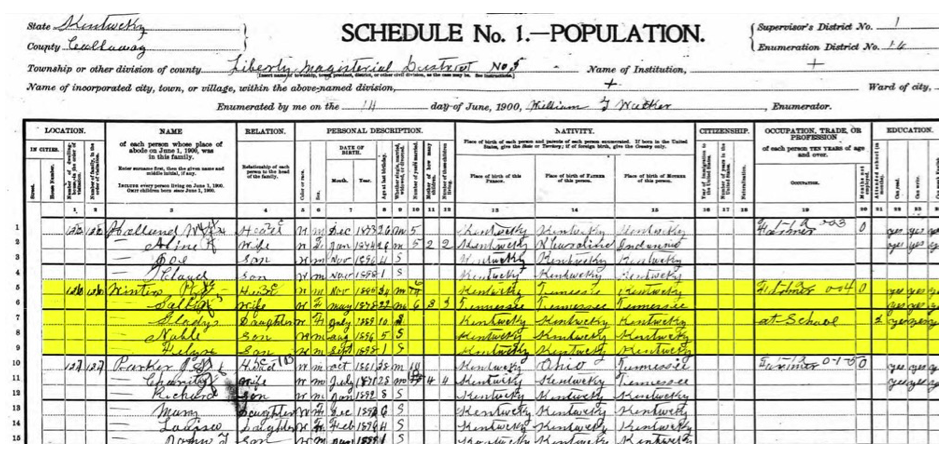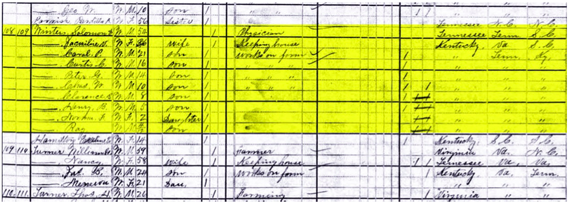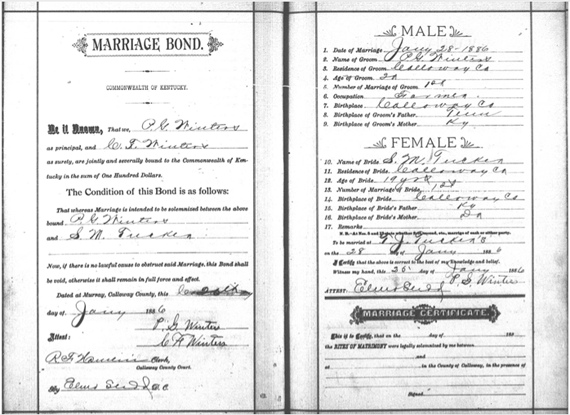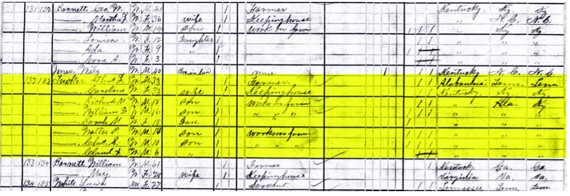I am new to Ancestry.com and I am hoping you can help me. My great-great-grandmother is S. Mottie Winters. She was born 22 January 1866, possibly in Tennessee, and died 18 May 1891 in Murray, Kentucky. She is listed on Find A Grave, but that is the only mention I can find of her. She died shortly after she married Peter Gardner Winters. They had one daughter, Gladys (my great-grandmother).
Peter married Sallie (Ellis, I think). They had five or six children and there is no more mention of Mottie. I'd like some help in finding out more about her. -- Barbara Cassell
_________
Dear Barbara,
It's completely understandable that you are having a difficult time locating information on Mottie. Until recently, when women married, their identity became cloaked under their husband's surname. To compound the problem you face, you have only an initial for your ancestor's first name and the name "Mottie," for her middle name, which is most probably a nickname; in fact, "Mottie" is sometimes a nickname for Martha. Another challenge you're facing is the gap in documentation left by the destruction of the 1890 U.S. federal census after a fire at the Commerce Department in Washington, D.C., in 1921.
Finding Mottie's death record would have been our ideal starting point. But when we searched Kentucky, Death Records, 1852-1953 on Ancestry, we were unable to locate her death. As we browsed through the years available for Calloway County, where the town of Murray is located, it was easy to see why. There is a gap in the records between 1878 and 1902. Although the first legislation aimed at the civil registration of all births and deaths in Kentucky was passed in 1852, compliance was sporadic until the 20 century.
Since we won't be able to find the family in the 1890 census, the one census year when they would most likely have been enumerated together, we started our search with Mottie's daughter and husband, Gladys Winters and Peter Gardner Winters in the 1900 census. Even though Mottie had died by this time, finding father and daughter together would give us details about each of them that will help us identify the family in other records that we might find. Murray is in Calloway County, Kentucky, and we found Gladys and Peter (listed as P.G.) Winters living in Liberty, Calloway County, Kentucky. Peter has already remarried to Sallie and they have two additional children by this time.

Jumping back to the 1880 census, we find a Peter G. Winters living with his parents. Because of Calloway County's location along the Kentucky/Tennessee state line, we searched for Peter Winters in Tennessee as well and located only one other Peter Winters in either state. Details in that record made it easy to eliminate him.

Knowing that Peter was in Calloway County, Kentucky, in both of the censuses surrounding the couple's marriage, we worked on the assumption that this was the most likely site for their marriage. Searching for a marriage record, we found a marriage index entry for P.G. Winters and S.M. Tucker. Knowing that the actual record could include important details not found in the index, we obtained a copy of that record. (This is very, very important, when searching for any ancestor; indexes only go so far.) On the marriage bond, the ages are relatively consistent with the records we have found to date, and Calloway County is listed as the birth place for both the bride and groom. Although the parents are not named, their birthplaces are given, and the record tells us that the couple was to be married at "T.J. Tucker's."

Turning back to the 1880 census, we found an entry, also in Liberty, in Calloway County, Kentucky, for Thomas J. Tucker. Thomas is the father of a daughter named Sarah M. Tucker, and Sarah is of the correct age to be S. Mottie Winters! We found this entry in the same township where Peter and the Winters family were enumerated, and the entries are only three census pages apart, which means that they lived fairly near each other, a good sign that this is indeed S. Mottie Winters.

While there is an inconsistency in the birthplace of the father listed on the marriage record and the birthplace listed on the 1880 census, because weddings at this time in our country's history were often held at the home of the bride, we believe that Thomas J. Tucker is her father. That said, further documentation should be sought to identify Thomas' actual place of birth as well as further details about this relationship.
As we searched for these families in earlier censuses, we had some difficulties locating some of the relevant parties. For example, we were able to locate Peter's father, Dr. Solomon Winters, in Calloway County in 1860, but not in 1870. In 1860 we also found the marriage of Thomas Tucker and Carolina Skaggs, Sarah M. Tucker's parents, in Stewart County, Tennessee, which is just to the southeast of Calloway County, Kentucky. Carolina's family is living in Calloway County in 1860, and interestingly, her father is also a doctor.
In fact, there seemed to be a lot of doctors in this rural Kentucky county! Dr. Solomon Winters' neighbor was also a doctor. Why so many doctors? This is quite fascinating. The area around Liberty Township was in the northeastern section of Calloway County. The county boundary to the east is the Tennessee River. An article about this area's role in the Civil War, published by the Jackson Purchase Historical Society, The Civil War in Murray, Calloway County, Missouri, by Robert W. Caldwell, describes the prevalence of malaria and typhoid here at this time. The need for doctors would have been critical, and at this time when anyone could hang out his shingle without a license, many men may have seized the opportunity to become "doctors," regardless of their qualifications.

Dr. Solomon Winter seems to have ministered to a good number of residents; according to the 1860 census, he held real estate valued at $1,500 and his personal estate was valued at $3,000. When his estate was settled in 1890, it records a lengthy list of debts owed him, mostly likely by his patients.
During the Civil War between 1861 and 1865, Calloway County was not a safe place to live. Soldiers and ex-soldiers from both the Union and the Confederate armies roamed the area, looting and killing residents. At one point the county seat at Murray was burned. So it is perhaps not surprising that some of the residents are missing in 1870. In the 1860 census, there were 9,915 residents in the county. In 1870, that number had surprisingly dropped to 9,410 - a loss of 515 residents (5%), a possible indication that the residents here suffered through a great deal of violence. (Census Bureau Report, page 65.)
Another possible explanation is that residents in this Confederate-leaning area may have been resistant to being enumerated in the federal census following the war. Calloway County is part of what's known as "The Jackson Purchase." According to the Caldwell article, this area was sometimes referred to as the "South Carolina of Kentucky," an area deeply sympathetic to the Confederacy in what was officially a Border State.
At any rate, a next step would be to do a more thorough canvassing of Calloway and neighboring counties to see if perhaps the families are hiding behind a mis-transcribed record, which happens more often that one would imagine. As we searched the 1870 census for this area, we noticed that some of the images are rather faded, but you can enhance these images by inverting the colors, and that could help you find the families if you browse through them carefully.
We're also at a point in the history of Kentucky where the parents of many of your ancestors would have been born in another state. Make note of associates of the family and neighbors in the census who share the same state of birth as your ancestors do. Families often moved in clusters and sometimes neighbors moved through chain migration, which is when one family (or several families) from a community would venture ahead, then write home about their new circumstances, enticing other families to follow. Be sure to make note of migration patterns that are sometimes evidenced in the birthplaces of the children.
You'll want to conduct thorough research on siblings and collateral relatives of your direct ancestors as well. The clues to your ancestor's origins may be found on death and other records of their relatives. Plus, they're a part of your family story, and their stories could be quite fascinating.
Another rich resource would be church records. The Find A Grave entry you found for S.M. Winters gives her burial location as Friendship Church of Christ Cemetery. She may have been affiliated with that congregation and they may have retained records of baptisms or other religious records.
Your ancestors lived in interesting, but difficult, times and places. We wish you the best of luck in discovering the rest of their intriguing story!
Do you have a mystery in your own family tree? Or have you wondered what family history discoveries you could make with a DNA test? Send Henry Louis Gates, Jr. and his team of Ancestry experts your question at ask@ancestry.com.